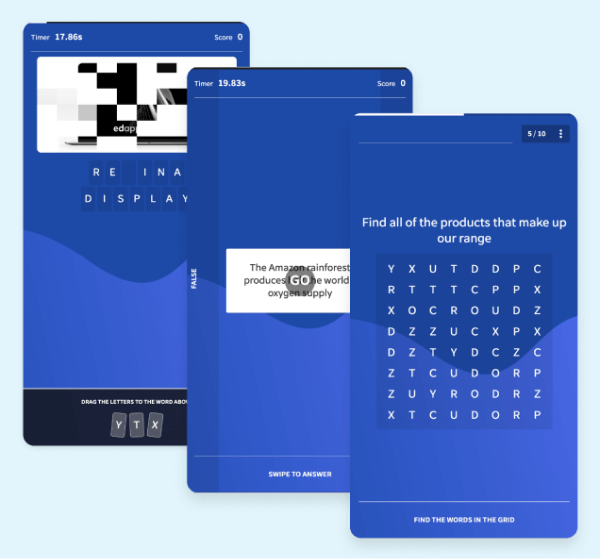Interactive Training

For the longest time, PowerPoint decks, Word docs, and PDFs have been a staple for presenting learning content. But to keep up with modern times, dwindling attention spans, and the changing needs of learners, it’s time to take your training to the next level through interactive training, which provides a more immersive experience that will help achieve better learning outcomes.
What is interactive training?
You might be asking yourself, what is interactive training? To put it simply, interactive training, also known as active learning, is an approach where learners are not mere listeners but active participants who engage with their training content. The goal is to involve them in the learning process as much as possible through different elements or activities within their training material. Interactive training activities can come in many forms, such as games, quizzes, simulations, 360° images and videos, and more. This can be applied to different learning methods and types of employee training, such as microlearning, just-in-time training, experiential learning, and more. Particularly with topics like online management courses, cyber security training, workplace health and safety, quality control training programs, and more.
Sign up for free and start using the best LMS for interactive training
Benefits of Interactive Learning
There are multiple reasons why interactive training is becoming a popular choice when presenting learning content. Let’s look into some of the benefits of interactive learning and interactive training and how you can also leverage them.
Increased engagement
When learners have direct participation in their training content, it motivates them to engage and be more interested in their lessons. A big aspect of this can be attributed to gamification, wherein lessons contain game-like elements and objects that allow learners to interact with the material. In eLearning, this can be achieved by creating lessons that include selecting choices to be able to progress, navigating 360 images, and exploring virtual and augmented reality environments. This gives them a sense of control over how they take information and become stimulated in the process, which also helps combat short attention spans.

Better knowledge retention
Interactive learning enables learners to consume content at their own time and pace. Putting them in the driver’s seat gives them time to fully absorb information and focus on areas they need to remember more. Having the visual, auditory, and even kinesthetic aspects. This also allows them to further reflect and review since they’ll get immediate outcomes and feedback from their activities.

Immediate feedback
With interactive learning, there’s no more waiting around by the end of their training to know how much participants have learned or understood. With this approach, learners are required to respond to the content, which in turn gives them instant feedback. This way, they’ll be able to know immediately what the correct answers are, what went wrong, and what they could have done differently the next time they encounter certain problems, questions, or scenarios. Aside from getting feedback from the training content itself, there’s also an advantage for trainers as they can monitor and evaluate learner progress in real-time.

Using interactive devices and implementing training programs in the workplace
Now that we’ve seen how interactive training can help with your training and learning outcomes, let’s take a closer look at how this can be applied and implemented in your training programs.
Include interactive elements
Interactive training goes beyond your simple mouse clicks and standard multiple-choice questions. Modern technology makes it easy now to build your interactive training programs and bring them to life. With tools to improve the learner experience and a learning management system, such as EdApp, you’ll be able to create interactive and engaging training in minutes. Its state-of-the-art authoring tool will be loved by both new and experienced L&D teams due to its ease of use. You’ll have access to over 80 intuitively designed microlearning templates that you can edit and customize as you wish. These interactive templates include games, parallax motion, scratch to reveal, word construction, and many more. They are designed to engage learners by actively asking them to interact with the training content before they can proceed to the next slide. This consistency in interaction also gives them a break from reading long chunks of text, which can help prolong their attention span.

Test your learners
A common way to test your learners is through exams and quizzes. The norm usually is that learners take them and then have to wait a certain amount of time before they’re graded. Or, if that’s automatically done, they could find out how they fared but would have to wait for the questions to be discussed to find out where they went wrong and what the correct answers are.

With tools to create an interactive quiz like EdApp’s Rapid Refresh, you can test learners while they get feedback and reinforcement at the same time as they go through the questions. Here, you’ll have the option not only to enter your questions and answers in an easy-to-complete spreadsheet, but also to enter some reinforcement text. This text appears as a pop-up to your learners once they have answered the question. Regardless of whether they answer correctly or incorrectly, the message is shown and is relevant to either outcome.
Incorporate gamification
Games are a surefire way to gain the interest of your learners and keep them engaged and motivated. Going through training content with game-like scenarios and activities makes learning feel like not another mundane work chore but instead an activity that they can look forward to. In interactive devices and tools, games can come in the form of simulated environments, which are perfect for high-risk industries, such as construction, engineering, and medicine, where participants can try their hand at various situations without real-life consequences. Branching scenarios with good storytelling is also another good option where learners go through a choose-your-adventure style game where they have to make choices to progress through their lessons. This empowers them to make decisions, which also improves problem-solving and decision-making skills in the process.

Games are also a great way to include key information for management development courses, keeping participants engaged and motivated.
Author
Gabrielle Rivera
Gabrielle is an eLearning content writer for EdApp, a microlearning solution designed for today's digital habits. She creates content about cutting-edge learning technologies and resources to help companies deliver great training experiences. When not absorbed in writing, she spends her time playing video games and reading books.
